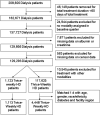Concurrence of Serum Creatinine and Albumin With Lower Risk for Death in Twice-Weekly Hemodialysis Patients
- PMID: 27528412
- PMCID: PMC5326741
- DOI: 10.1053/j.jrn.2016.07.001
Concurrence of Serum Creatinine and Albumin With Lower Risk for Death in Twice-Weekly Hemodialysis Patients
Abstract
Objective: Markers of better nutritional status including both higher levels of serum albumin (as a measure of visceral proteins) and creatinine (as a measure of the muscle mass) are associated with lower mortality in conventional (thrice weekly) hemodialysis patients. However, data for these associations in twice-weekly hemodialysis patients, in whom less frequent hemodialysis may confound nutritional predictors, are lacking.
Design and subjects: We identified 1,113 twice-weekly and matched 4,448 thrice-weekly hemodialysis patients from a large national dialysis cohort of incident hemodialysis patients over 5 years (2007-2011). Mortality risk, adjusted for potential confounders, was examined across two-by-two combinations of serum creatinine (<6 vs. ≥6 mg/dL) and albumin (<3.5 g/dL vs. ≥3.5 g/dL) for each treatment frequency yielding a total of 8 groups.
Results: Patients were aged 70 ± 14 years and included 48% women and 55% diabetics. Using the thrice-weekly hemodialysis patients with creatinine ≥ 6 mg/dL and albumin ≥ 3.5 g/dL as reference, patients with creatinine <6 mg/dL and albumin <3.5 g/dL had a 1.8-fold higher risk of mortality (hazard ratio: 1.75, 95% confidence interval: 1.33-2.30) in twice-weekly and 2.2-fold increased risk of mortality (hazard ratio: 2.21, 95% confidence interval: 1.81-2.70) in thrice-weekly hemodialysis patients, respectively in fully adjusted models adjusted for demographics, comorbidities, and markers of malnutrition and inflammation. A test for interaction showed that there was no significant difference in albumin creatinine mortality associations between twice-weekly and thrice-weekly hemodialysis patients (P-for-interaction = .7667).
Conclusions: Surrogate markers of higher visceral protein and muscle mass combined may confer greatest survival in both twice-weekly and thrice-weekly hemodialysis patients.
Copyright © 2016 National Kidney Foundation, Inc. Published by Elsevier Inc. All rights reserved.
Figures





Similar articles
-
The influence of patient- and facility-specific factors on nutritional status and survival in hemodialysis.J Ren Nutr. 2004 Apr;14(2):72-81. doi: 10.1053/j.jrn.2004.01.006. J Ren Nutr. 2004. PMID: 15060871
-
Validation of serum transthyretin (prealbumin) as a nutritional parameter in hemodialysis patients.J Ren Nutr. 1998 Jul;8(3):142-9. doi: 10.1016/s1051-2276(98)90006-1. J Ren Nutr. 1998. PMID: 9724504
-
Independent and joint associations of nutritional status indicators with mortality risk among chronic hemodialysis patients in the Dialysis Outcomes and Practice Patterns Study (DOPPS).J Ren Nutr. 2010 Jul;20(4):224-34. doi: 10.1053/j.jrn.2009.10.002. Epub 2010 Jan 8. J Ren Nutr. 2010. PMID: 20060319
-
Nutritional status of twice and thrice-weekly hemodialysis patients with weekly Kt/V > 3.6.J Med Assoc Thai. 2009 May;92(5):624-31. J Med Assoc Thai. 2009. PMID: 19459522
-
B-type natriuretic peptide levels and volume status in twice-weekly hemodialysis patients.Ren Fail. 2021 Dec;43(1):1259-1265. doi: 10.1080/0886022X.2021.1971091. Ren Fail. 2021. PMID: 34465266 Free PMC article.
Cited by
-
Incremental dialysis: review of the literature with pediatric perspective.Pediatr Nephrol. 2024 Jan;39(1):49-55. doi: 10.1007/s00467-023-06030-9. Epub 2023 Jun 12. Pediatr Nephrol. 2024. PMID: 37306719 Review.
-
The phase angle cut-off point capable of discriminating hemodialysis patients with reduced exercise tolerance: a cross-sectional study.BMC Sports Sci Med Rehabil. 2024 Feb 2;16(1):34. doi: 10.1186/s13102-024-00825-5. BMC Sports Sci Med Rehabil. 2024. PMID: 38308310 Free PMC article.
-
Depression and quality of life in older adults on hemodialysis.Braz J Psychiatry. 2020 Apr;42(2):195-200. doi: 10.1590/1516-4446-2018-0345. Epub 2019 Aug 5. Braz J Psychiatry. 2020. PMID: 31389496 Free PMC article.
-
The epidemiology and microbiology of central venous catheter related bloodstream infections among hemodialysis patients in the Philippines: a retrospective cohort study.BMC Nephrol. 2024 Oct 2;25(1):331. doi: 10.1186/s12882-024-03776-8. BMC Nephrol. 2024. PMID: 39358687 Free PMC article.
-
Incremental versus conventional haemodialysis in end-stage kidney disease: a systematic review and meta-analysis.Clin Kidney J. 2023 Nov 8;17(1):sfad280. doi: 10.1093/ckj/sfad280. eCollection 2024 Jan. Clin Kidney J. 2023. PMID: 38186889 Free PMC article.
References
-
- Coresh J, Selvin E, Stevens LA, Manzi J, Kusek JW, Eggers P, Van Lente F, Levey AS. Prevalence of chronic kidney disease in the United States. JAMA. 2007;298(17):2038–2047. - PubMed
-
- US Renal Data System . USRDS 2012 Annual Data Report: Atlas of End-Stage Renal Disease in the United States. National Institutes of Health, National Institute of Diabetes and Digestive and Kidney Diseases; Bethesda, MD: 2012.
-
- Keshaviah PR, Nolph KD, Moore HL, Prowant B, Emerson PF, Meyer M, Twardowski ZJ, Khanna R, Ponferrada L, Collins A. Lean body mass estimation by creatinine kinetics. J Am Soc Nephrol. 1994;4(7):1475–1485. - PubMed
-
- Schutte JE, Longhurst JC, Gaffney FA, Bastian BC, Blomqvist CG. Total plasma creatinine: an accurate measure of total striated muscle mass. J Appl Physiol Respir Environ Exerc Physiol. 1981;51(3):762–766. - PubMed
Publication types
MeSH terms
Substances
Grants and funding
LinkOut - more resources
Full Text Sources
Other Literature Sources
Medical

